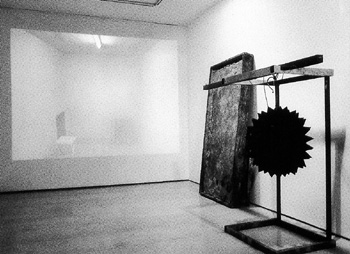Gregor Schneider
Sadie Coles HQ, London
Art+Text, Issue 61, May-Jul 1998

Image: Gregor Schneider, installation view
Gregor Schneider lives in an ordinary terraced house in Monchengladbach, Germany. At least to passersby, it is ordinary. Inside, it is far from mundane. The entranceway, for a start, is tiny. Unremarkable in itself, perhaps, but this small room can rotate 360 degrees. The fact that you can end up in one of several different spaces when exiting (depending upon the current rotation) offers a clue as to what the rest of the building might be like.
Schneider's house, as you might guess, is an ongoing art work. He is constantly rebuilding and adding new chambers, five of which are currently complete: guest room, bedroom, kitchen, bathroom, brothel. Polystyrene is a favorite building material; the rooms themselves are filled with 'sculptures' which consist primarily of trash: clothes, mattresses, bits of window frame, a blow-up doll, etc. Fairly unpleasant stuff.
But enough of Schneider's home life. At 'Brothel (Berlin)' at Sadie Coles HQ, he documents the project. Here are a set of small photographs detailing the transformations of the rooms, and a few of the sculptures themselves, most notably a three-dimensional geometric star carved from black foam.
The real interest of this show, however, are the two video works. These are filmed by the artist - whom we never see, apart from his shadow - as he crawls around the dark, foreboding rooms. The first consists of three monitors, each mounted on a different wall, each showing a different part of the house as seen by a mounted camera; on occasion, the camera is picked up and taken on a frenetic journey through the house. The second, and more involving, work is a wall-sized projection in a darkened space. The scale of the piece, coupled with the blackened room, draws us in to the projected space.
Of course, one recognizes the first-person perspective from horror movies in which the spectator occupies the vantage point of the evildoer approaching his or her victim. This technique was developed to signal the arrival of the danger, and yet simultaneously to avoid showing it, as nameless horror is always the most frightening. This reference is particularly germane as the specific rooms being explored in the large-screen work comprise the basement 'brothel'; all that clambering down through dark tunnels and detritus-strewn chambers recalls the final scenes from Silence of the Lambs.
However, along with horror film, the piece conjures the first-person perspective of Doom-style computer games: the way our viewpoint swings about, wildly exploring spaces before we head into them; the absence of narrative; and the fact that there is no speech, merely shuffling, heavy breathing, and the odd yelp of pain as Schneider clangs against some knackered piece of architecture. The gaming reference is interesting because it shifts the meaning of these videos away from the prosaic realm of documentation. If phenomenology is about experiencing the world through the senses, then these pieces, with their reference to virtual reality, are about removing the authenticating factor of 'presence' from the experience.
With the advent of computer games, the window of Renaissance perspective is no longer a wholly convincing metaphor, which is to say we are no longer beholders of a tableau, but rather participants in a fully immersive environment. All of which has serious implications when we remember that perspective, as Erwin Panofsky pointed out, is not merely a technique, but an ideology. When we discover the ideological implications of this particular perspectival shift, I am sure we will find that Schneider is already there.
— End —